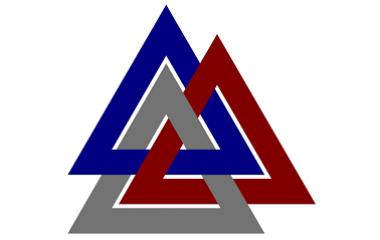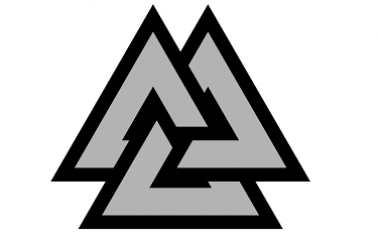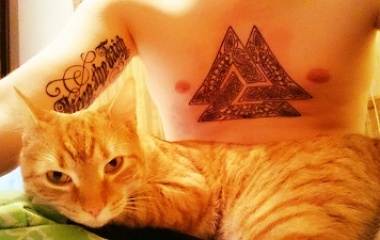Through trance, chanting and possibly even sex magic, practitioners of magic and shamanism from the Viking age could supposedly control people’s minds and weave the strands of fate to suit their desires. Their powerful blessings fortified their warriors for battle and their curses would crush their enemies. These shaman left behind an ancient symbol, called the Valknut, which represented their magical powers.
What Is the Valknut?
The Valknut (pronounced: val-knoot) is a symbol in Nordic mythology depicting three interlocked triangles. The name ‘Valknut’ is a modern word, meaning ‘slain warrior knot’, and was created recently in the Norwegian language. The Valknut symbol itself, however, dates back to ancient times and relates to the cult of the dead. An example of the Valknut symbol was found in the 7th century in Gotland, Sweden on the Tängelgårda stone. The three triangles of the Valknut were seen most often on gravestones and runestones, usually alongside the figure of Odin, or the animals which represented him, the horse or wolf.
Origin
A number of possible explanations of the origins of the Valknut have been suggested by historians. The Valknut symbol was believed to be linked to Odin, a revered and powerful god in Nordic mythology. Odin’s name translates as “Master of Ecstasy”. He was a powerful magician associated with wisdom, war, poetry, shamanism, magic, and the dead. He had the ability to use magic to bind and unbind things, and thereby control people’s minds. The Valknut is said to be a symbol of that binding and unbinding magic.
The heathen Norse shamanism and magic, also called Seidr (pronounced SAY-der), was generally only practiced by women. Men who followed the practice were persecuted as such things went against the Germanic social norms of the time. The female followers would collectively pray, chant and go into a trance during the rituals. According to certain sources, the rituals may have incorporated the use of sexual energy and stimulation: sex magic. The staff used in the ceremonies approximates a phallic epithet, as noted in numerous Nordic writings. The practitioners were able to control the path of reality and its various threads by reaching a higher level of consciousness and traveling through the Nine Worlds to glimpse the future and achieve their goals.
The Nine Worlds are the domains of the different types of beings and include the world of humanity, gods and goddesses, giants, ice, fire, elves and the dead. The Nine Worlds are also held in the branches of the world tree, the Yggdrasil (pronounced IG-druh-sill). The ash tree is the center of the Norse spiritual world. Odin transports himself between the worlds by riding his horse, Sleipnir, through the branches of the world tree.
The Valknut is also said to be related to Hrungnir‘s heart, mentioned in Snorri Sturluson’s Prose Edda. Hrungnir was a giant and the spirit of night, winter, darkness and the grave. He had a heart made of stone which had three pointed corners. Due to the visual description not being very detailed, however, this is not the most popular view of the Valknut source.
The three triangles and nine points of the Valknut are said to symbolize fertility, rebirth and reincarnation, and its interlocking triangles perhaps show the connection between Earth, Hel (the goddess who rules over the underworld, Helheim) and the heavens.
Similar Symbols
The Valknut symbol is comparable to the three-horned symbol found on the Snoldelev Stone, a runestone from the 9th century originally found in Snoldelev, Denmark. The stone also has a symbol of a swastika on it, which was a common symbol in that period. The Nazis, who later adopted the symbol, believed they were descendants of the Vikings. The swastika symbol, in actual fact, dates back over 11 000 years and has previously been used by Hindus, Buddhists and Jains. In Norse mythology the swastika apparently represented Odin moving through all the worlds as a flying disk. Other sources state it meant a blessing or good luck in the Nordic religion, taking those bearing the symbol from a state of chaos to a state of order and strength.
A stone-carved symbol of a triple spiral, called the Triskele, dating back to pre-Celtic and Celtic times, is yet another symbol similar to the Valknut. It is believed to be connected to the sun, the afterlife, and reincarnation, as well as pregnancy.
Modern use
A less widely used version of the Valknut, the Triceps symbol, resembles the Valknut with its triangle formed by three diamonds. It was a symbol of magical protection and is used today as a symbol of the Asatru. Asatru means ‘the belief in the gods’ and is a modern revival of the Norse pagan religion. It has become wide-spread over North America, Europe and Australasia. The movement’s beliefs are centered on the pre-Christian belief system of the ancient Germanic people, and practitioners worship many gods and goddesses. The goal of Asatru is to live a worthwhile life. Instead of acceding to a modern sense of morality, follower’s values are based on Nine Noble Virtues: truth, courage, discipline, honor, fidelity, hospitality, perseverance, industriousness, and self-reliance.
Symbols like the Valknut can carry great significance and a hidden depth of emotion for many people. Their meanings can become convoluted over time and often represented notions which seem extraordinary or even supernatural to us today. The ancient Nordic shamans left us the Valknut as a symbol of their magic. The Valknut is a reminder of their power, the power to control the path of destiny!











Odin’s name does not mean ‘master of ecstasy’ his name descends from the proto-germanic word ‘Woedinn’ meaning ‘The Fury’
I found myself drawn to the Valknut symbol so much that I had it tattooed onto my left wrist. Having it fills me with strength, honour, courage, and pride in my beliefs. This symbol is a bold one… one held to the end.
For asatru believers such as myself the Valknut is very much a symbol connected with Odin so much so that to have it tattooed on your skin is a public pronouncement of ones dedication to Odin in life and in death and there are even some kindreds that believe so deeply in this dedication to the high one that members must subject themselves to a ritual known as ”Odin’s ordeal “ and complete it successfully before they can wear the symbol permanently on their skin either in the form of a tattoo or a permanent scar from carving the Valknut into ones skin upon completion of the “orde”
Was it jorney that said…” Don’t stop believing, hold onto that feeling?”
so scary 🙂